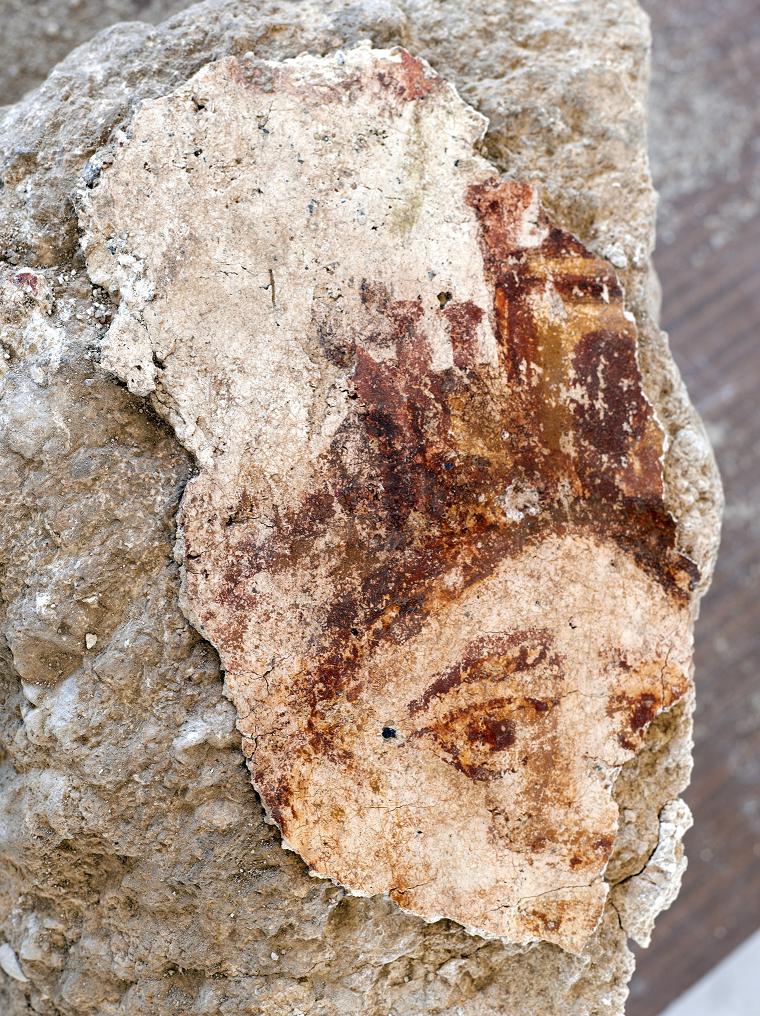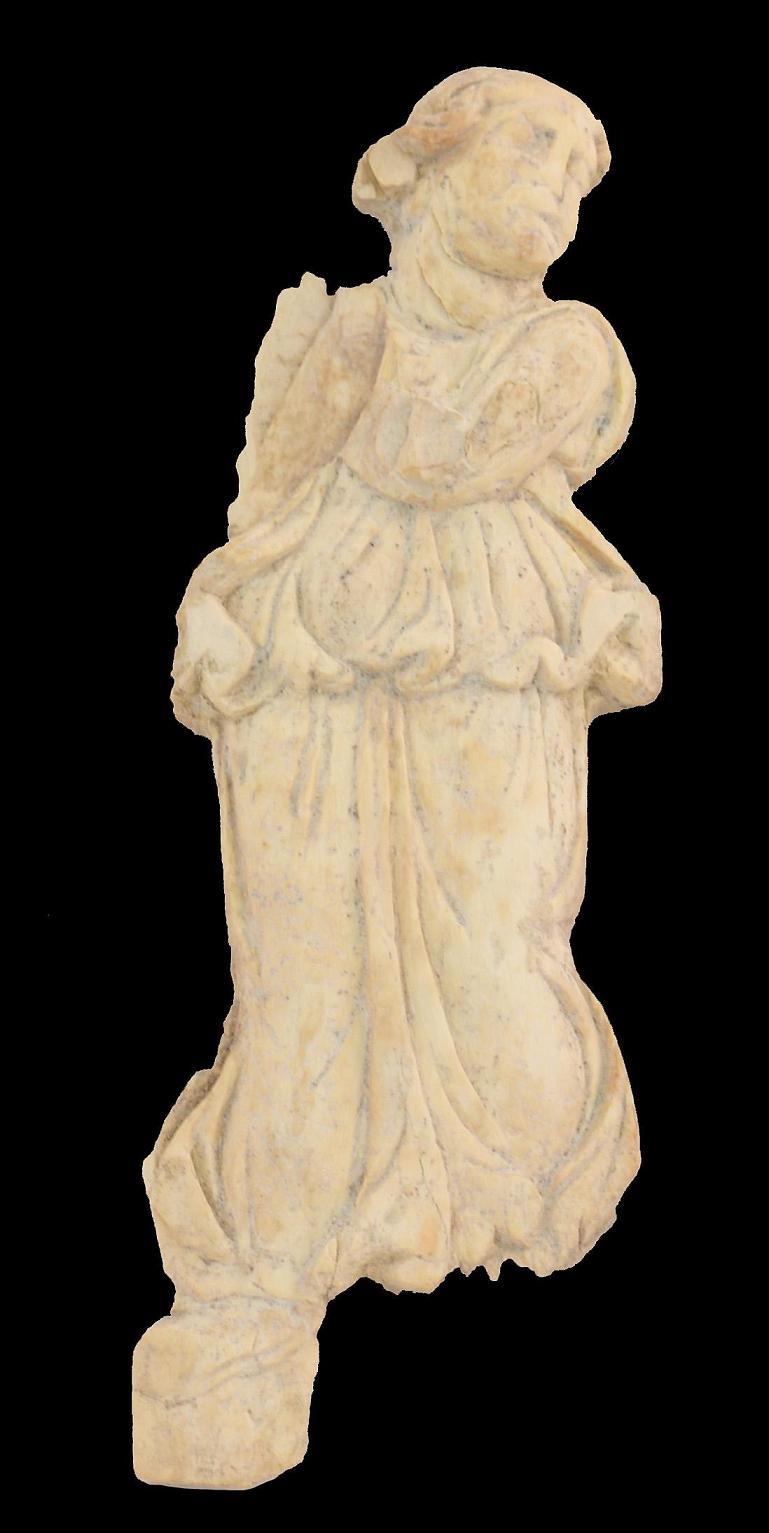During the excavation season, which has been managed for the 11th year by the University of Haifa, a wall painting of Tycha, the Greek goddess of luck, was found. There is also a bas-relief of Minada, one of the attendants of the god of wine, in the middle of a stormy dance.

Part of a wall painting (fresco) of Tycha, the Greek goddess of luck, was uncovered during the 11th season of excavations at the Susita site managed by Haifa University researchers. Another female figure found in this season is that of a minade, one of the attendants of the wine god Dionysus.
"It is interesting to see that even though the residence where the two goddesses were found existed even in the Byzantine period, when Christianity abolished and erased idolatry, you can still find clear evidence of the ancient beliefs," said Prof. Arthur Segal and Dr. Michael Isenberg from the Zinman Institute of Archeology at the University Haifa who are at the head of the excavation. The city of Susita is located in the heart of the Susita National Park, which is managed by the Nature and Parks Authority, which has helped a lot this season to continue the excavations and preserve the findings.
During the excavations of a group from Concordia University led by Prof. Mark Shuler in a residence, which according to the quality and complexity of the construction, probably belonged to one of the dignitaries of the city, the diggers came to the inner courtyard with a small fountain in the center. Next to the fountain, the excavators found the fresco of Tycha (Fortuna, in Roman mythology), who was apparently dedicated to being the city's goddess of luck. The goddess's head was adorned with a crown, her young gaze was focused and her brown hair was abundant under the crown. According to the researchers, according to an artistic analysis, it is reasonable to date the wall painting to the end of the Roman period or the beginning of the Byzantine period (third-fourth centuries AD).

But Ticha was not the only mythological figure found in this complex. On a bone plate is a remarkably accurate relief of a minade: one of a group of holy women who accompanied the procession of the wine god Dionysus. According to the researchers, according to Greek mythology, the Maenads accompanied Dionysus in boisterous dances, holding the thyrsus, an accessory symbolizing sexuality and fertility. Susita's minade was also designed while she was in the midst of a stormy dance.
As mentioned, according to the researchers, the two female evidences of Greco-Roman idolatry can be dated to the end of the Roman period, but there is no doubt that the residence where they were found continued to exist even after Christianity defeated the idols.
This season, the city's basilica from the Roman period (first-second centuries AD) has finally begun to be revealed, a multi-dimensional structure that contained the city's central commercial, social and judicial area. Along with some of the finest architectural items discovered in Israel, made of marble, the researchers also found decorations made of "stucco" - plaster used as a cheap imitation of marble. "We couldn't help but wonder how a relatively humble city could employ first-class builders and craftsmen. The stucco decorations taught us that, in spite of everything, the rulers of the city were definitely not indifferent to the expenses and construction costs," the researchers noted.
Susita was founded on top of Mount Nisha east of the Kinneret, in the second century BC by the Slovak rulers, who were the masters of the land at the time. The city existed during the Hellenistic, Roman, Byzantine and Umayyad periods, until it was destroyed by the intense earthquake of 749 AD. Along with Beit Shean and other cities east of the Jordan, Sosita was part of the cultural-geographic block of the cities of the "Decapolis": the field of action where Jesus performed most of the miracles described in the New Testament.

8 תגובות
Daniel - I loved it 🙂
:)Eiran, moreover, it was the first car in history that fit the food chain, the camels loved to eat it :) and hence it was also the first car that fit the environmental ecology..
But who is Ticha's mythological partner? :)
The title of the article is poetic because "the goddess of fortune was found in Susita"... speaking the truth when you mean the modern Susita is the Israeli mythological car that we built from fiberglass and somehow this Styrofoam with wheels drove and drove well 🙂
Who said there is no God and no luck 🙂
For all those interested:
The word "God" in ancient Hebrew means "power". - Hence the "goddess of luck", "god of the sun" etc. are the "power of luck", "the power of the sun" etc. - which shows that our ancestors were not as stupid as we think... the personification of those forces/gods came at a later stage Because of the criminal interests of various priests and shamans who ruled through the intimidation of the masses. The distinction between "god" and "idol" is purely political, with each side calling the opponent's "gods" - "idols".
[By the way, the name "Eyal" means "power" and not the male of the doe...]
Like the difference between a jerk and a jerk
Berdichevsky, I have already forgotten what the difference between a god and an idol is.
Who can remind us? Who can save us?
Twenty-five virtual internet cookies for correct answers!
A very interesting and impressive find.
The experts state that Christianity is not a pagan religion??????
They are really experts apparently!!!???